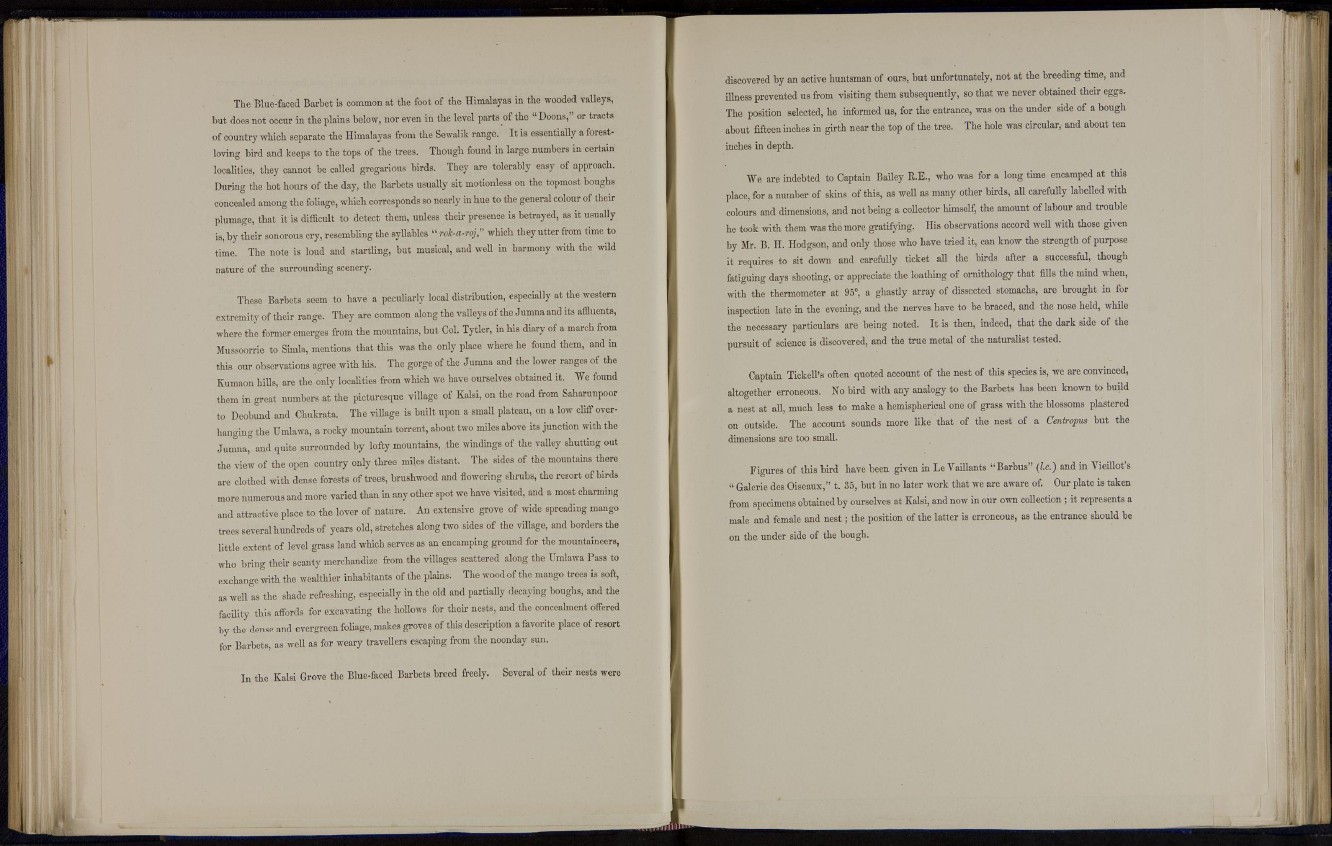
The Blue-faced Barbet is common at the foot of the Himalayas in the wooded valleys,
but does not occur in the plains below, nor even in the level parts of the "Doons," or tracts
of country which separate the Himalayas from the Sewalik range. It is essentially a forestloving
bird and keeps to the tops of the trees. Though found in large numbers in certain
localities, they cannot be called gregarious birds. They are tolerably easy of approach.
During the hot hours of the day, the Barbets usually sit motionless on the topmost boughs
concealed among the foliage, which corresponds so nearly in hue t o the general colour of their
plumage, that it is difficult to detect them, unless their presence is betrayed, as it usually
is, by their sonorous cry, resembling the syllables " rok-a-roj," which they utter from time to
time. The note is loud and startling, but musical, and well in harmony with t h e wild
nature of the surrounding scenery.
These Barbets seem to have a peculiarly local distribution, especially at the western
extremity of their range. They are common along the valleys of the Jumna and its affluents,
where t h e former emerges from the mountains, b u t Col. Tytler, in h i s diary of a march from
Mussoorrie to Simla, mentions that this was the only place where he found them, and in
this our observations agree with his. The gorge of the J u m n a and t h e lower ranges of the
Kumaon hills, are the only localities from which we have ourselves obtained it. We found
them in great numbers at the picturesque village of Kalsi, on the road from Saharunpoor
t o Deobund and Chukrata. The village is built upon a small plateau, on a low cliff overhanging
the Umlawa, a rocky mountain torrent, about two miles above its junction with the
Jumna, and quite surrounded by lofty mountains, the windings of the valley shutting out
the view of the open country only three miles distant. The sides of the mountains there
are clothed with dense forests of trees, brushwood and flowering shrubs, the resort of birds
more numerous and more varied t h a n in any other spot we have visited, and a most charming
and attractive place to the lover of nature. An extensive grove of wide spreading mango
trees several hundreds of years old, stretches along two sides of the village, and borders the
little extent of level grass land which serves as an encamping ground for the mountaineers,
who bring their scanty merchandize from the villages scattered along the Umlawa Pass to
exchange with t h e wealthier inhabitants of the plains. The wood of the mango trees is soft,
as well as the shade refreshing, especially in the old and partially decaying boughs, and the
facility this affords for excavating the hollows for their nests, and the concealment offered
by the dense and evergreen foliage, makes groves of this description a favorite place of resort
for Barbets, as well as for weary travellers escaping from the noonday sun.
I n the Kalsi Grove t h e Blue-faced Barbets breed freely. Several of their nests were
discovered b y an active huntsman of ours, but unfortunately, not at the breeding time, and
illness prevented us from visiting them subsequently, so that we never obtained their eggs.
The position selected, h e informed us, for t h e entrance, was on the under side of a bough
about fifteen inches in g i r th near the top of the tree. The hole was circular, and about ten
inches in depth.
We are indebted to Captain Bailey R.E., who was for a long time encamped at this
place, for a number of skins of this, as well as many other birds, all carefully labelled with
colours and dimensions, and not being a collector himself, t h e amount of labour and trouble
he took with them was t h e more gratifying. His observations accord well with those given
by Mr. B. H. Hodgson, and only those who have tried it, can know the strength of purpose
i t requires to sit down and carefully ticket all the birds after a successful, though
fatiguing days shooting, or appreciate the loathing of ornithology t h a t fills t h e mind when,
with the thermometer at 95°, a ghastly array of dissected stomachs, are brought in for
inspection late in t h e evening, and the nerves have t o be braced, and the nose held, while
the necessary particulars are being noted. It is then, indeed, that the dark side of the
pursuit of science is discovered, and t h e true metal of the naturalist tested.
Captain Tickell's often quoted account of the nest of tliis species is, we are convinced,
altogether erroneous. No bird with any analogy to the Barbets has been known to build
a nest at all, much less to make a hemispherical one of grass with t h e blossoms plastered
on outside. The account sounds more like that of the nest of a Centropus but the
dimensions are too small.
Figures of this bird have been given in L e Vaillants ' ' B a r b u s " (I.e.) and in Yieillot's
" Galerie des Oiseaux," t. 35, but in no later work that we are aware of. Our plate is taken
from specimens obtained by ourselves at Kalsi, a n d now in our own collection ; i t represents a
male and female and n e s t ; the position of the latter is erroneous, as the entrance should be
on the under side of the bough.